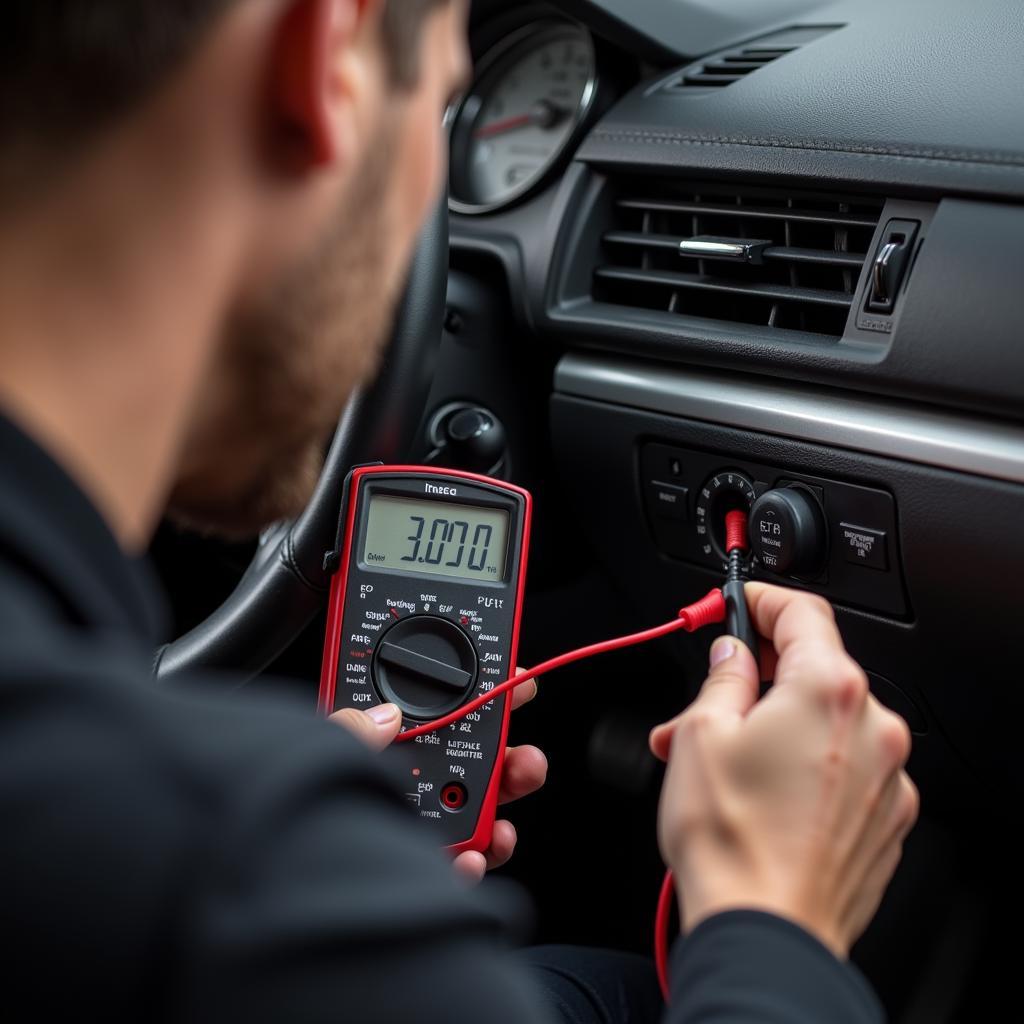Car Tyre Maintenance often gets overlooked, but it’s crucial for both your safety and your wallet. Properly maintained tyres provide better fuel efficiency, improved handling, and a smoother ride. This comprehensive guide will equip you with all the knowledge you need to keep your tyres in top shape, whether you’re a car owner, a mechanic, or a car enthusiast.
 Checking Car Tyre Pressure
Checking Car Tyre Pressure
Why is Car Tyre Maintenance So Important?
Your car tyres are the only point of contact between your vehicle and the road. They endure constant stress from braking, accelerating, turning, and even just carrying the weight of your car. Neglecting their maintenance can lead to:
- Reduced Tyre Lifespan: Worn-out tyres are more prone to punctures and blowouts, requiring premature replacement.
- Compromised Safety: Worn tyres offer less grip, especially on wet surfaces, significantly increasing the risk of accidents.
- Poor Fuel Economy: Underinflated tyres create more rolling resistance, forcing your engine to work harder and consuming more fuel.
- Uneven Tyre Wear: Improper maintenance can cause uneven wear patterns, leading to vibrations and reduced tyre life.
Essential Car Tyre Maintenance Tips
Follow these essential tips to ensure your tyres remain in optimal condition:
1. Regular Tyre Pressure Checks
Tyre pressure changes with temperature fluctuations and over time. Driving on underinflated or overinflated tyres is dangerous and can lead to uneven wear.
How to check tyre pressure:
- Locate the recommended tyre pressure for your vehicle. You can usually find it on a sticker inside the driver’s side door jamb or in your owner’s manual.
- Use a reliable tyre pressure gauge. Digital gauges tend to be more accurate.
- Check the pressure when the tyres are cold (before driving or at least three hours after driving).
- Remove the valve cap from the tyre valve stem.
- Press the gauge firmly onto the valve stem until the hissing sound stops.
- Read the pressure on the gauge and compare it to the recommended PSI.
- Add or release air as needed to reach the recommended pressure.
- Repeat for all four tyres, including the spare.
Expert Insight: “Many drivers underestimate the importance of tyre pressure. Even a small deviation from the recommended PSI can significantly impact handling and tyre life,” says John Miller, a senior mechanic with 20 years of experience.
 Measuring Tyre Tread Depth
Measuring Tyre Tread Depth
2. Tyre Tread Depth Inspection
Tread depth is crucial for maintaining grip, especially in wet conditions. Insufficient tread depth significantly increases the risk of hydroplaning.
How to check tread depth:
- The Penny Test: Insert a penny into the tread groove with Lincoln’s head facing down. If you can see the top of Lincoln’s head, your tyres are too worn and need replacing.
- Tread Depth Gauge: For a more accurate measurement, use a tread depth gauge. Place the gauge in the main tread grooves at several points around the tyre. If the reading is below 2/32 of an inch, it’s time for new tyres.
3. Tyre Rotation
Tyres wear out at different rates depending on their position on the vehicle. Regular tyre rotation helps even out this wear, extending the lifespan of your tyres.
General recommendations for tyre rotation:
- Every 5,000-8,000 miles or as recommended in your owner’s manual.
- Rotate front-to-back and back-to-front for vehicles with non-directional tyres.
- Consult a professional for vehicles with directional tyres or different tyre sizes on the front and rear axles.
4. Wheel Alignment
Proper wheel alignment ensures that your wheels are pointing in the correct direction and are parallel to each other. Misalignment can cause uneven tyre wear, pulling to one side, and reduced fuel efficiency.
Signs of misalignment:
- Your vehicle pulls to one side while driving.
- The steering wheel vibrates.
- You notice uneven or rapid tyre wear.
Expert Insight: “Regular wheel alignment not only extends tyre life but also improves fuel efficiency and handling, making your drive smoother and safer,” says Sarah Thompson, a certified automotive technician.
5. Visual Tyre Inspection
Regularly inspect your tyres for visible signs of damage or wear.
What to look for:
- Cuts, cracks, or punctures: These can lead to air leaks or sudden tyre failure.
- Bulges or blisters: These indicate internal damage to the tyre structure and require immediate replacement.
- Objects lodged in the tread: Remove any foreign objects like nails, screws, or stones.
- Uneven wear patterns: This could be a sign of misalignment, improper inflation, or suspension problems.
Tubeless Tyre Maintenance
Many modern vehicles come equipped with tubeless tyres. While these offer advantages like better puncture resistance and slower air leaks, they require specific maintenance.
For information on maintaining tubeless tyres, you can refer to our guide on tubeless car tyre maintenance.
Conclusion
Car tyre maintenance is not just about extending the life of your tyres; it’s about ensuring your safety and the safety of others on the road. By following these simple yet crucial tips – checking tyre pressure, inspecting tread depth, rotating tyres, getting wheel alignments, and performing visual inspections – you can significantly prolong the life of your tyres and enjoy a safer, more economical, and smoother driving experience.
If you have any concerns about your car tyres or need professional assistance, don’t hesitate to contact AutoTipPro at +1 (641) 206-8880 or visit our office at 500 N St Mary’s St, San Antonio, TX 78205, United States.
FAQs
1. How often should I check my tyre pressure?
It’s recommended to check your tyre pressure at least once a month and before any long road trips.
2. Can I repair a punctured tyre myself?
While temporary tyre repair kits are available, it’s always best to have a professional assess and repair a punctured tyre.
3. How long do car tyres typically last?
The lifespan of car tyres varies depending on driving habits, road conditions, and maintenance. However, most tyres should be replaced every 25,000 to 50,000 miles.
4. What are the signs of worn-out tyres?
Signs of worn-out tyres include low tread depth, visible cracks or bulges, excessive vibration while driving, and poor handling, especially on wet roads.
5. Does car insurance cover tyre damage?
Tyre damage is typically not covered under basic car insurance policies. However, you might have coverage if the damage is a result of a covered incident, such as a collision.






Leave a Reply